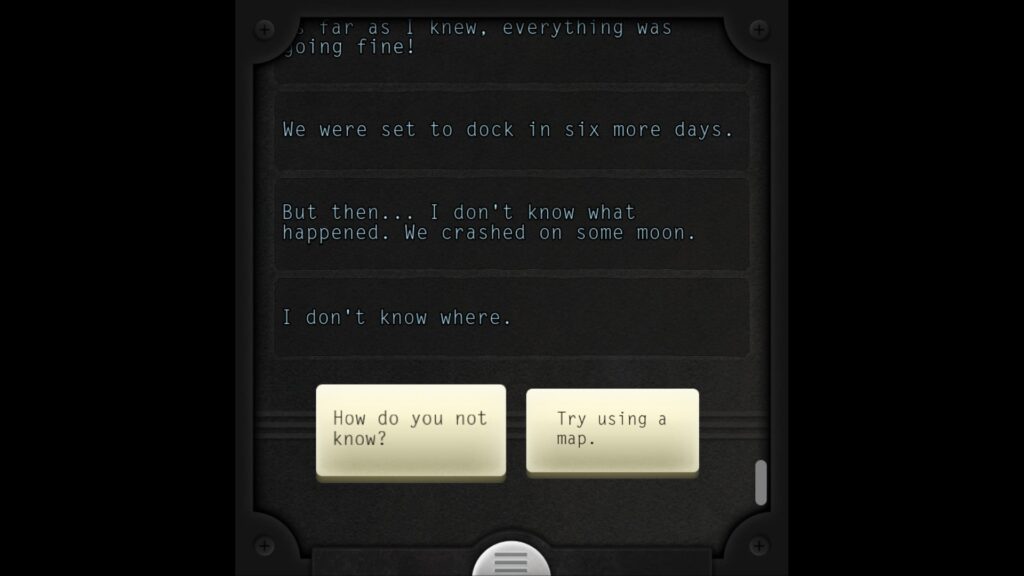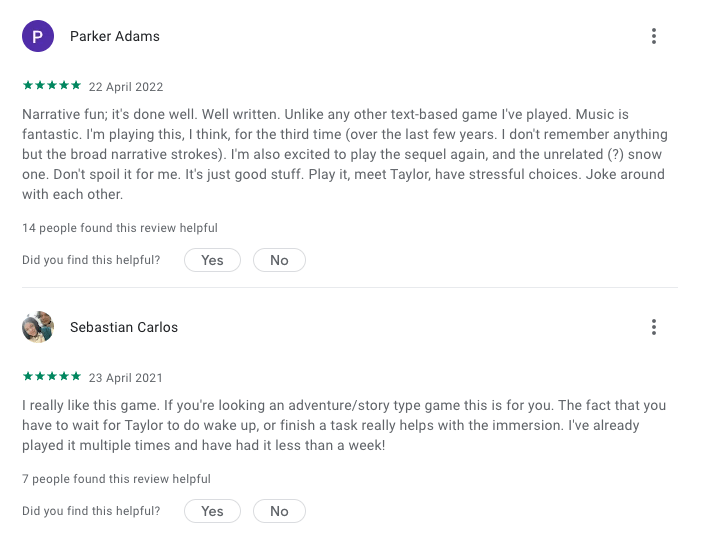“Hello? Is this thing working? Can anyone read me?”
It’s with these three simple sentences that the original Lifeline begins. And the player has to make their very first choice. How do they respond? Already, your path can diverge (though it’ll quickly circle back). After learning that Taylor has landed in a rocky desert, the player can recommend investigating a crash site or heading for a white peak.
It’s here that Lifeline’s true mechanic begins. As Taylor walks to their destination, the player will have to wait in real-time – sometimes hours – before Taylor sends their next message.
And that’s the key to the Lifeline series. Players don’t just respond and pick a path; they wait in real-time and can reply through their phone or smart-watches notification menu – as though responding to a real person.
How a text-based adventure fits on mobile
As a premium game, with over half a million downloads on Google Play alone, a 4.6-star rating, and seven sequels – 3 Minute Games has clearly done well for themselves. In fact, the series was so beloved that the original developers bought back the rights to the IP and started releasing sequels due to the sheer amount of fan demand.
But 3 Minute Games didn’t start as a separate studio. It was originally part of Big Fish Games – an experimental arm to test new waters and explore new spaces. Lifeline wasn’t the only game they came up with – but it was the one that stuck.
We spoke with Mars Jokela – Lifeline’s game designer – and Dave Justus – the writer behind the scenes – to ask them what advice they had for other developers and what it was about Lifeline that worked.
Focus on a concept
“Notifications were the key,” Mars told us. “Apple had just announced that there would be an interactive lock screen on the iPhone – you could reply right from the lock screen. That was the genesis of the idea.”
The idea actually sat around for a while until Apple announced the Apple Watch.
“That lit a fire under the concept,” Mars added. “It was obvious that this wearable device was going to be perfect. So we thought – let’s keep the scope small and focus on this one specific idea. We actually put out six or seven different games – super simple and small concepts. Hyper-casual, before hyper-casual was even a thing.”
They were essentially creating prototypes, like Poll Party, where you’d get prompted to answer a quick poll. But all of them shared the same initial concept: Use the notification menu somehow.
“That was the philosophy at the time: How do we address this concept we’re trying to make?” Mars said. “Most were simple ideas but ended up needing too much backend work. We put out about seven games in that first period, all based on the game idea. That’s why it’s so important to express that singular concept.”
In fact, Mars explained that you don’t need to be completely original. You just need that one nugget that’s unique to your game. Branching storylines like Lifeline have been a cornerstone of gaming since the ZX Spectrum – but the notifications and real-time schedule transformed it into a unique game.
Execution does matter
The key to making sure that your game or prototype is going to be successful is polish. You don’t need to add hundreds of meta-features straight off the bat – if you’ve got the core gameplay loop sorted. Those extra mechanics can come later.
“Even if it’s a small game, make it feel good and honest to your concept,” Mars said. “Don’t ship out games with half-finished content or mechanics. They can be small and focused, as long as you fully express your idea. With Lifeline, we had just enough at the start – you can make binary choices, and you’re stranded on the moon. That was enough to work with.”
Once Dave – the writer – joined the team, that concept evolved and changed dramatically as he wrote the story. But the core concept remained.
Figure out your guard rails
Constraints can actually lead to more creativity. The actual story behind Lifeline was heavily influenced by the limitations the mechanics imposed.
“We didn’t want the character to be gendered, we wanted it to be three days of real-time, I could only give players two choices, and we could only communicate through dialogue”, Dave explained. “So I was looking for places to add delays. An hour of walking. Eight hours of sleep. Even if it was ten minutes heading down a corridor.”

These creative constraints are what make Lifeline feel so real and compelling.
“Writing these games is very different to writing a comic script because it’s all dialogue,” Dave said. “Even if it’s expositional, like ‘I’m looking at this crater or spaceship’ – all of that needs to be words coming out of a character’s mouth. That can be tricky to make sound realistic.”
It’s not just narrative constraints that can help a developer create a realistic game. There are technical constraints, too.
“I’ve worked a lot developing for new platforms, with different interaction models,” Mars said. “Developing for a watch means you have to think differently about the game design. You have to think about how people are going to have to raise their arm to fiddle with the controls. What’s natural?”
Think of dialogue vines, not trees
Branching paths in the narrative are a huge part of a story-driven game. But they can be a nightmare to write.
“If you let it branch out too much, you’ll never capture the story,” Dave said. “It’s about taking little deviations from the main line and then weaving them back together. It’s actually easy to keep branching, but if you do that, you’ll end up with 64 passages with no endings.”
Instead, Dave suggests finding ways to get to the key story moments you want to tell. You don’t want to tell stories that are going to be hidden away on some tangential path that nobody will ever see.
“It’s more like a vine, than a tree,” Dave said. “Don’t hide your best scenes.”
Make sure choices matter
Writing your dialogue like a vine – rather than a tree – might sound like individual choices aren’t important. But that shouldn’t be the case.
“What makes a game a game is player agency,” Mars explained. “It’s a delicate balance. The player needs to feel like the choices they’re making matter. Even if that choice is that Taylor dies early. It’s fine to cut a path off and end it.”
Another technique is to bring back an element later in the story. The branch might come back together – run along the main vine for a significant time – but having that item or talking to that character might push the player down a completely different path later down the story.
Listen to feedback
As a story-based game, Lifeline doesn’t need to track how people progress through levels. But they do need to keep their finger on the pulse.
“We look at player sentiment a lot, read reviews and stay active in the community,” Mars explained. “What matters most is engaging the players – the strength of the writing.”

“The amount of love and devotion has blown us away,” Dave added. “We never thought this level of fan love was possible – we even get fan art and cosplay.”
Me and @Ghost_Logic went as the weirdly cool space and magic nerds at #dragoncon this year! @lifelinegame pic.twitter.com/QIYSp0NLqf
— Holly (@PekaSairroc) September 7, 2017
One key challenge from the community came when the team experimented with a free to play model.
“Lifeline’s player base didn’t love it, so the Lifeline Universe app never left beta,” Mars explained.
One reason for this was that micro-transactions break the immersion. Players need to suspend their disbelief if they’re going to relate to your characters and story. So interrupting them with ads or micro-transactions doesn’t work.
“The second your friend wants to charge you to tell you a slightly better joke, that’s when you stop talking to them,” Dave said.
For story games, it seems the best model is a one-off payment or subscription.
“We recently released Lifeline+ on Apple Arcade,” Mars said. “And it’s been great seeing a resurgence in activity. That subscription model, getting regular stories without interrupting the gameplay, that’s perfect for us.”
Keep up to date with the latest news
We definitely recommend keeping an eye on this space. Mars hinted that they’ve got a new project in the works, but that they’re not quite ready to talk about it. It should be coming out this year, so make sure you follow them on Twitter to get any updates there. And if you enjoyed hearing from 3 Minute Games and learning their advice, make sure you subscribe to our newsletter to stay in the loop.





















Discussion about this post